During deeper avalanche burials, the strongest signal is rarely directly above the victim. This is due to the way the transmitting beacon's flux lines propagate. Beacons with fewer than three antennas (and a few beacons with three antennas) will lead you to the strongest signal, which will be a point that is near, but not directly above, the victim.
At the start of the 2024-25 ski season, I tested the ability of seven popular avalanche transceivers to handle spikes. That isn't a large sample size but my results were very consistent.
To test the transceivers I mounted a transceiver vertically above the ground on a wood pole. I then "searched" for the transceiver by slowly moving a searching transceiver along the ground. I "bracketed" the distance readings that were displayed by the searching transceiver to find the location where it reported the shortest distance.
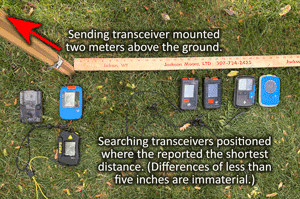
In a one-meter burial, the BCA Tracker 3, Ortovox Diract, and Pieps Pro IPS bracketed to within a few inches of the buried transceiver. The Barryvox S, Barryvox S2, Black Diamond Recon, and Ortovox Zoom+ were 7 to 11 inches to the side of the transmitting beacon.
As shown in this picture, the results were more material in a two-meter burial where the BCA Tracker 3, Ortovox Diract, and Pieps Pro IPS were still within a few inches of the buried transceiver, the Barryvox S and Barryvox S2 were 18 inches to the side, and the Black Diamond Recon and Ortovox Zoom+ were approximately 26 inches to the side of the transmitting beacon.
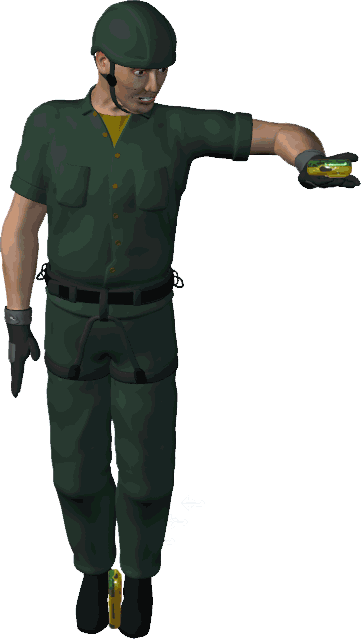 Here's a simplified test to see how well your transceiver handles spikes:
Here's a simplified test to see how well your transceiver handles spikes:
The distance indicator should decrease as it moves toward the center of your body. The lowest reading should be directly over the transmitting beacon. Transceivers with fewer than three antennas (and those with less than perfect firmware) will display the shortest distance when they are a foot or two away from the center of your body.
This test shows whether your transceiver handles spikes at approximately one meter (the distance between the transceivers), but spike handling is much more significant with deeper burials.
If your beacon leads you to a spike (i.e., a location that isn't directly over the transmitter), you will still find the victim with good probing technique (learn how at AvyRescue.com). For example, if you are one meter from the victim and you probe using 25 cm (10 inch) spacing, you will need to probe approximately 65 times to completely check within one meter of the spike. If it takes 5 seconds per probe (a wild guess), it will take you a little more than 5 minutes to completely probe the area.
The distance between the strongest signal and the transmitter is based on the orientation of the two transceivers and the depth of the burial. These possibly confusing signals are the result of the flux lines and are called spikes. This section explains spikes in more detail.
When the transmitting and receiving beacons are both on the surface of the snow, the receiving beacon will receive the strongest signal when it is directly above the transmitter (and the transceivers are almost touching). This is true regardless of the orientation of the two beacons and the number of antennas in the receiving beacon, because the transceivers are only a few inches from each other.
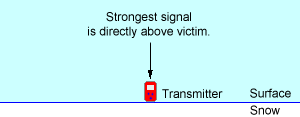
However, when the transmitting beacon is buried, this can change significantly. As shown below, when the receiving beacon has fewer than three antennas and is held horizontally, and the transmitting beacon is buried three meters deep in a vertical orientation, the strongest signal will be a meter or two away rather than directly over the buried beacon.
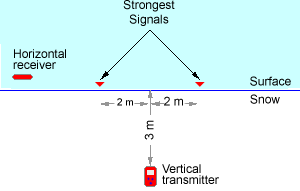
The strongest signal is the result of the flux lines.
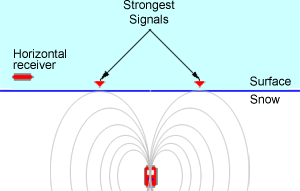
The actual distance between the strongest signal (the spike) and a point directly above the victim depends on many factors—primarily the burial depth and the transmitting antenna's orientation. In my extensive spike testing, the average distance from the strongest signal to the point over the victim was 0.55 meters (21 inches) on one-meter burials, 0.85 meters (35 inches) on two-meter burials, and 1.4 meters (four feet) on three-meter burials. (This was with the transmitting beacon in a vertical position and the receiving beacon in a horizontal position as shown above.)
It gets more complicated. When both the transmitting and receiving beacons are horizontal, the strongest signals occur directly over the victim and a meter or more on either side.
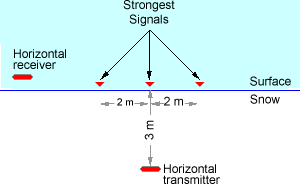
If the buried beacon is neither vertical or horizontal (which is usually the case), the spikes appear at varying distances from the victim.
All this would be more manageable if there were only two or three points on the surface of the snow, but the two or three points shown above assume you are traveling in a straight line (as would be the case if you are following the flux lines to the victim) and the beacons are precisely oriented. In the real world, these "spikes" appear as an oval on the surface of the snow surrounding the victim.
Three-antenna transceivers use a tiny, vertical, third antenna to analyze the flux lines and direct you to the point directly above the victim. Unfortunately, the three-antenna Ortovox X1, Ortovox Patroller, and Ortovox D3, while better than two antenna transceivers, do not accurately resolve spikes (I've confirmed this repeatedly with one-, two-, and three-meter burials). These three beacons consistently display the shortest distance when over the spikes rather than when over the victim (although they were closer to the victim than two antenna transceivers). That is unfortunate, because the only reason for a third antenna is to remove spikes from deeper burials.

You can learn more about my spike testing here. You can learn more about multiple antennas here. You can read about how most Ortovox transceivers transmit on a different antenna based on the transceiver's physical orientation here. You can read a somewhat complicated article about dealing with spikes-and-nulls during deep burials here.